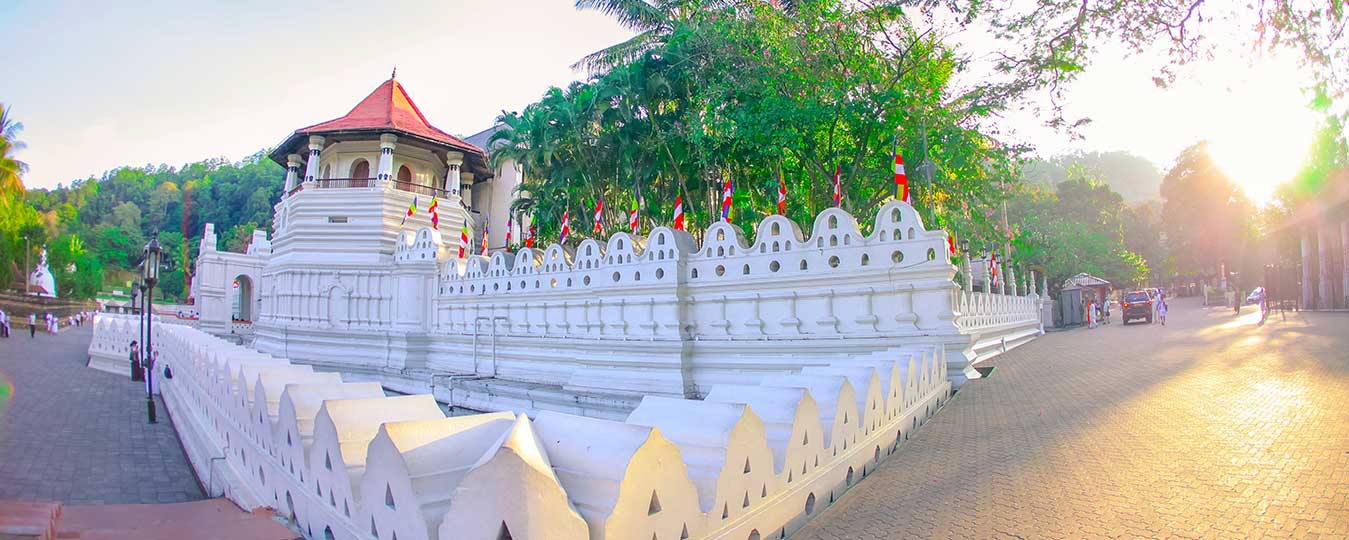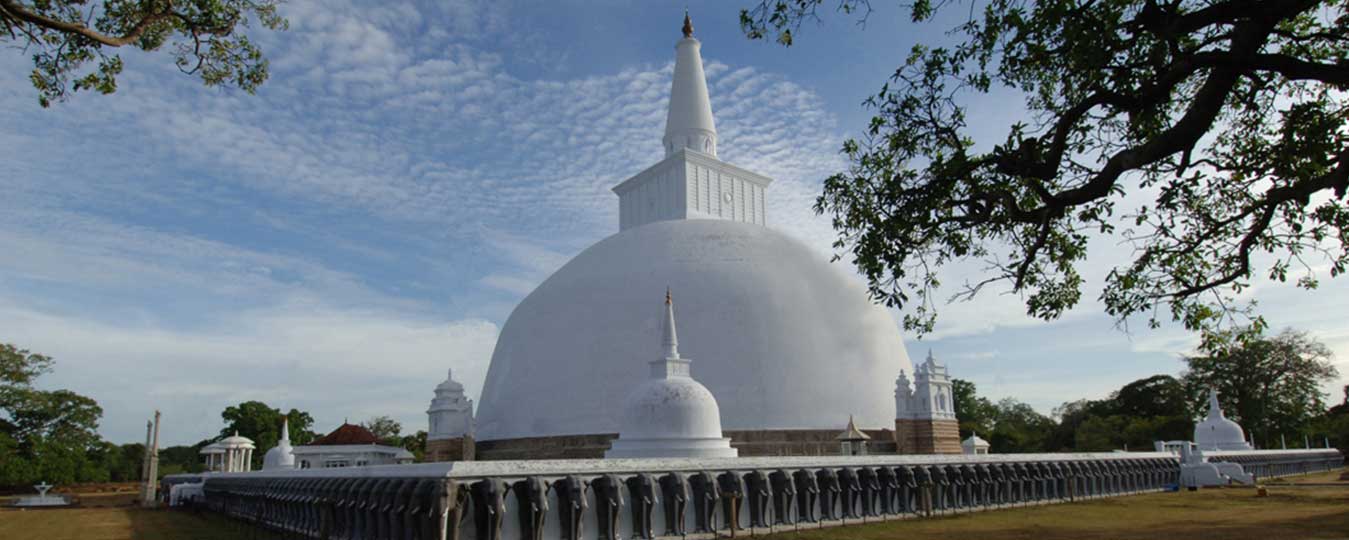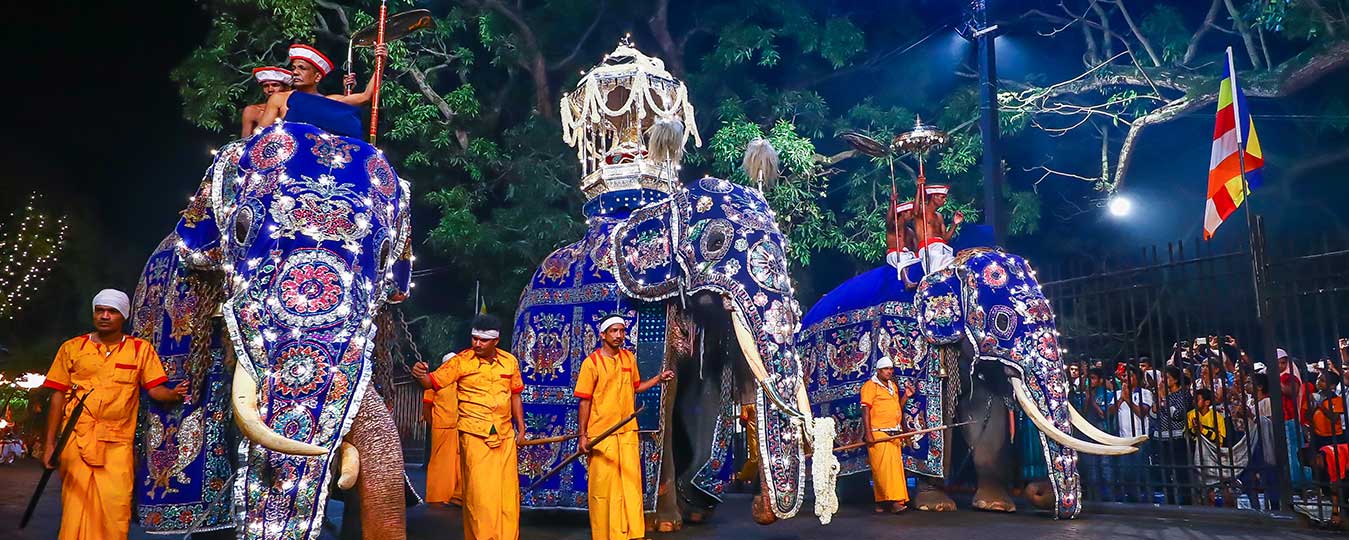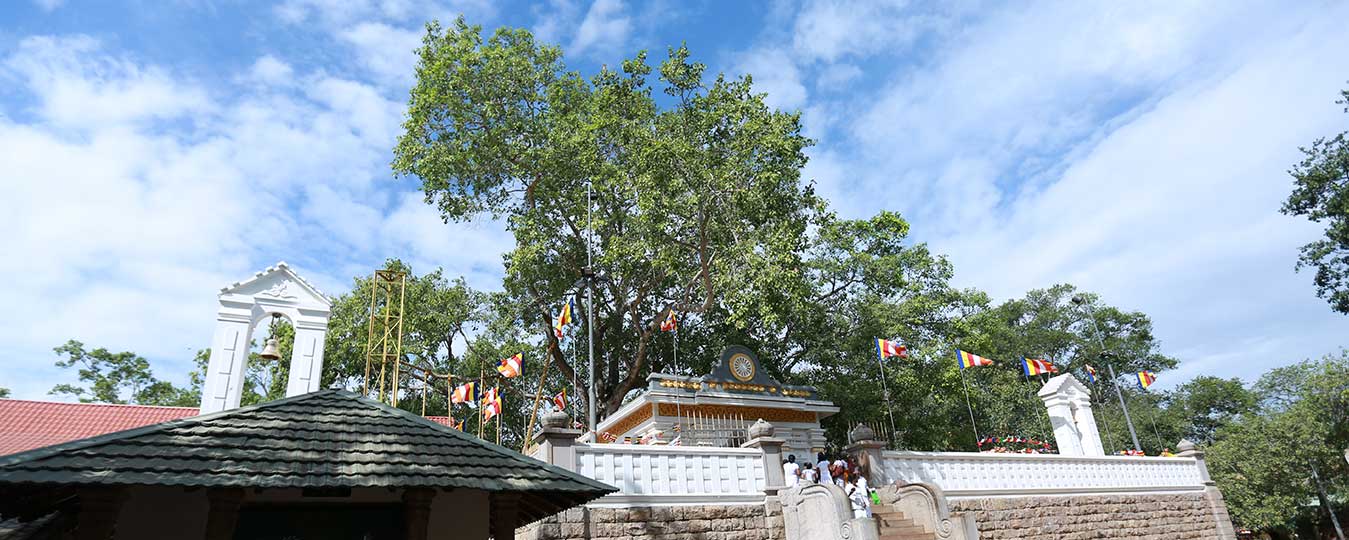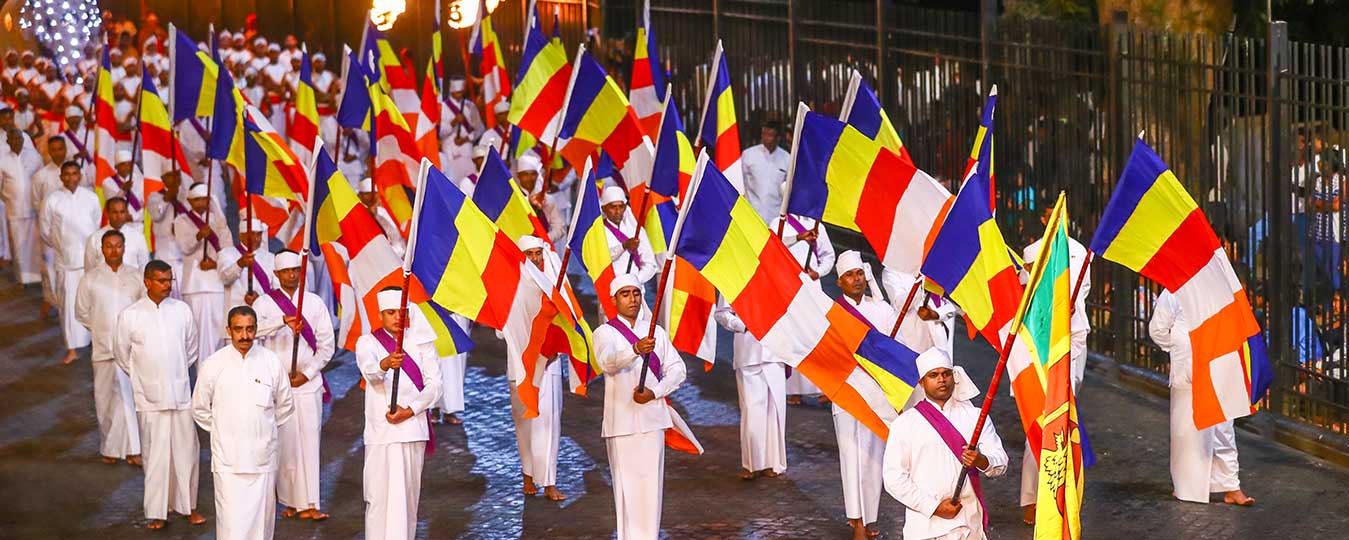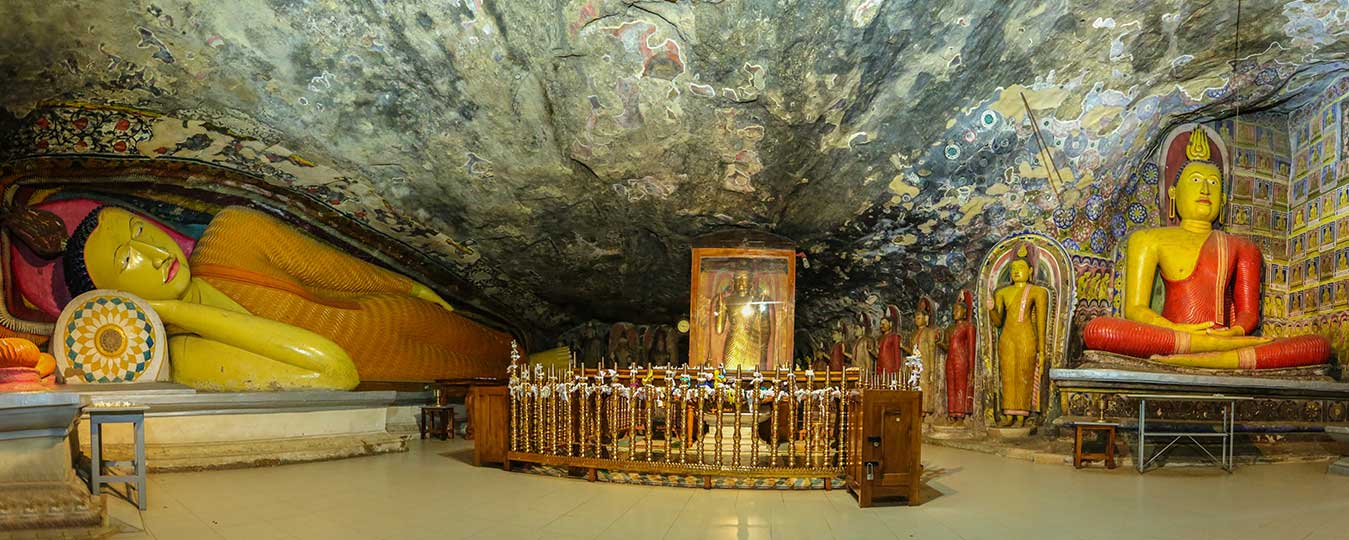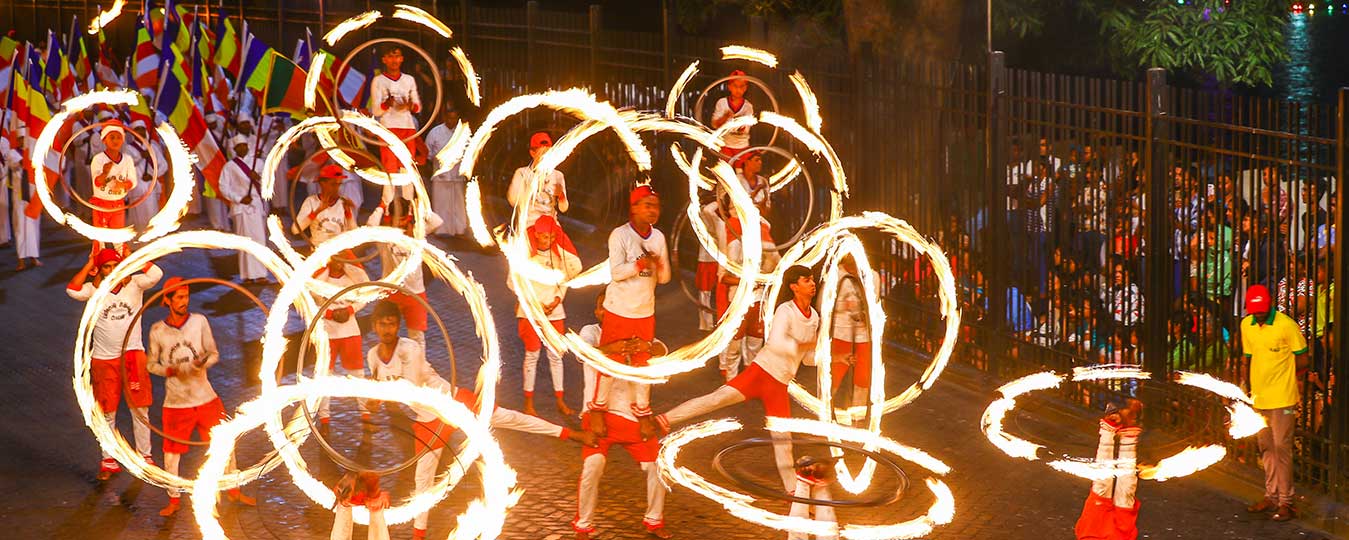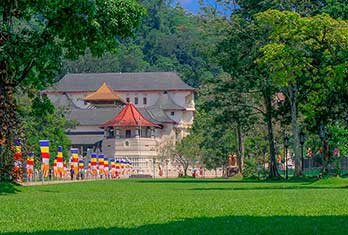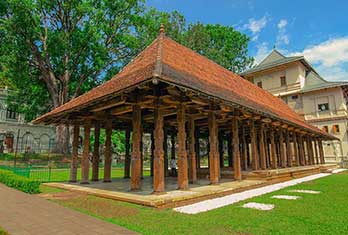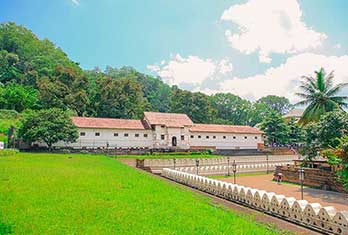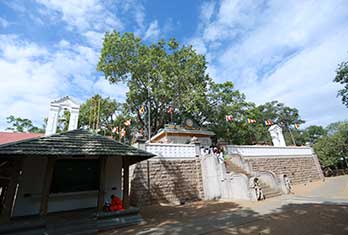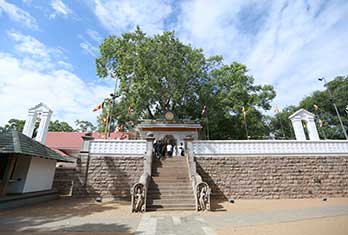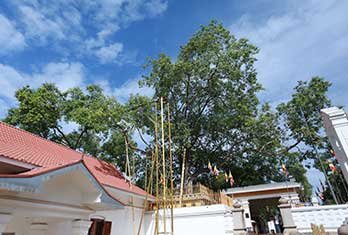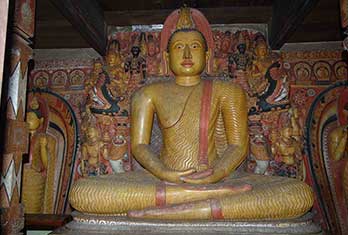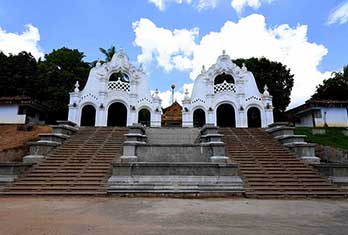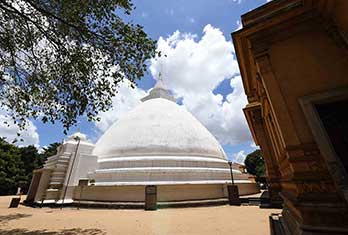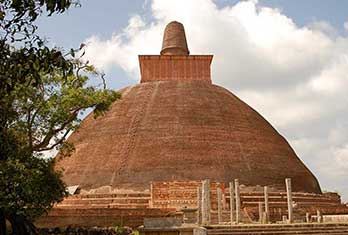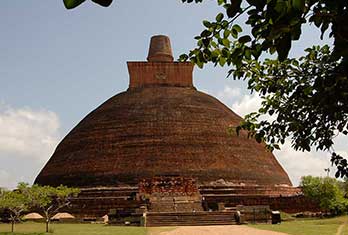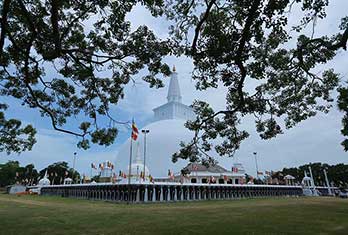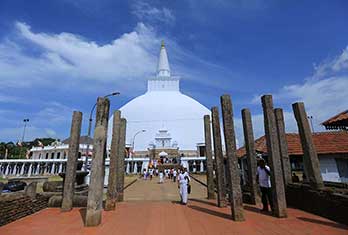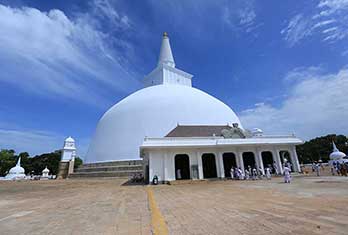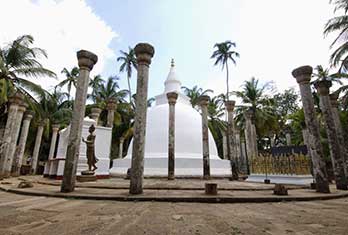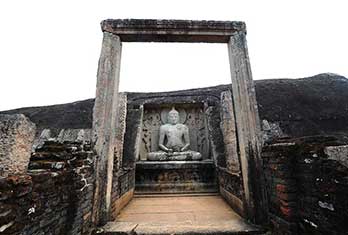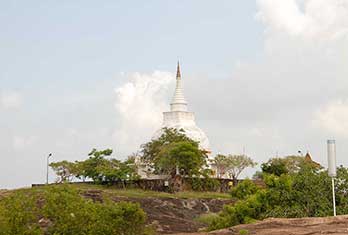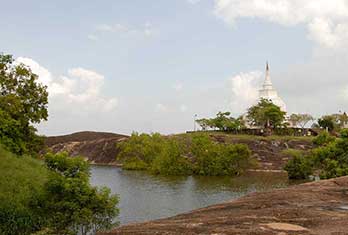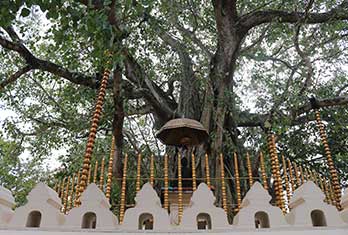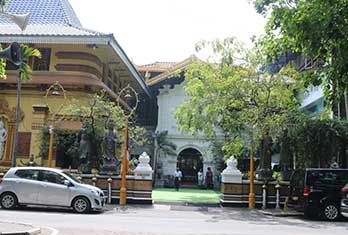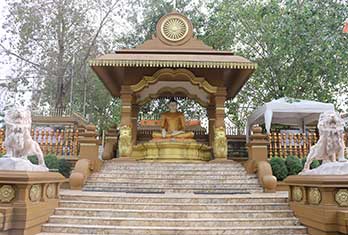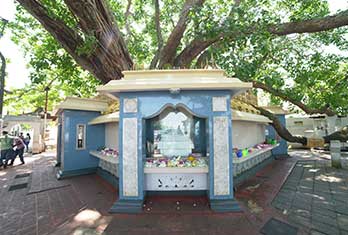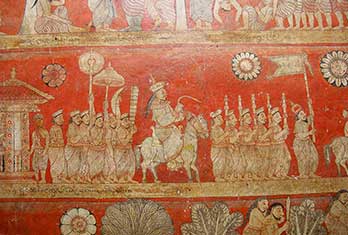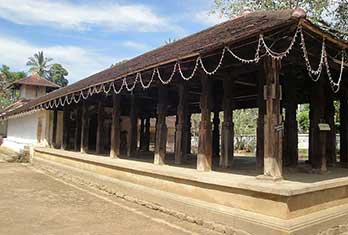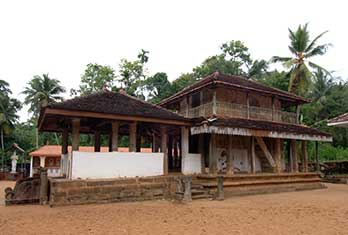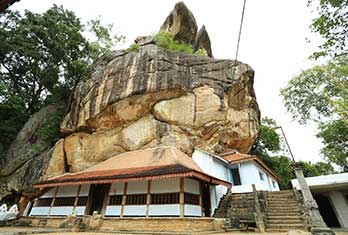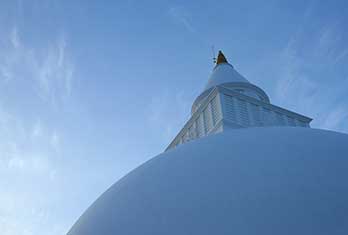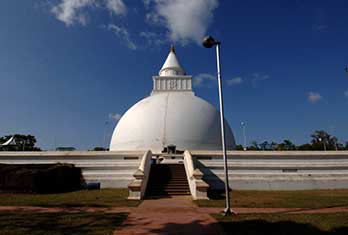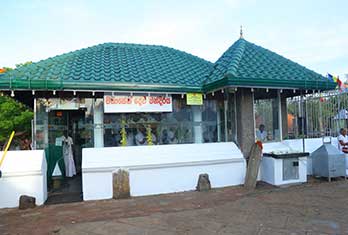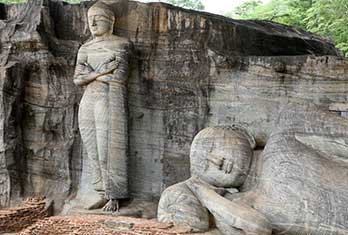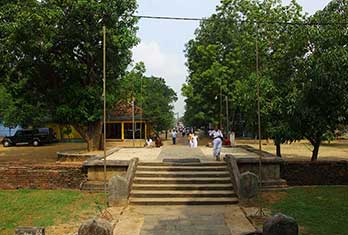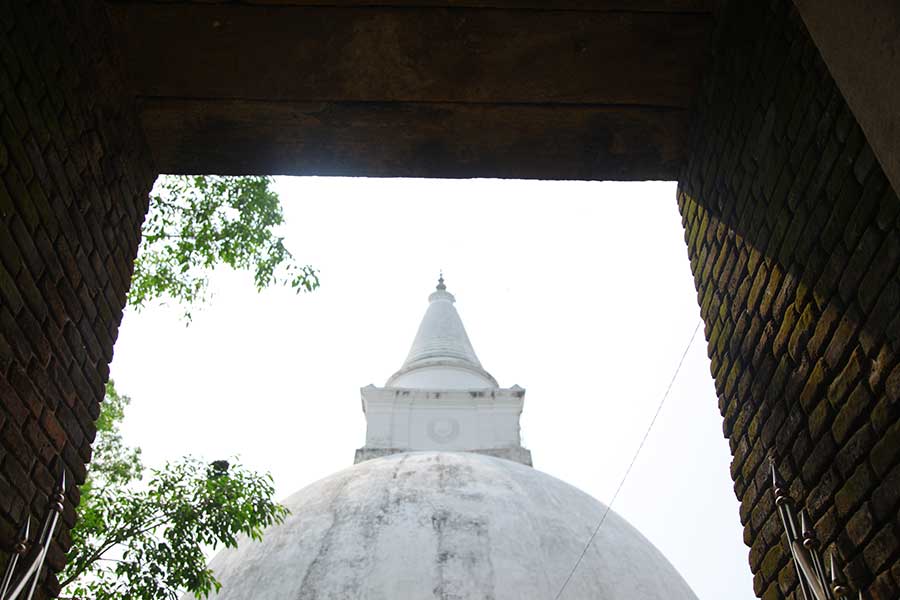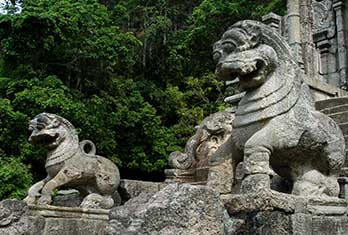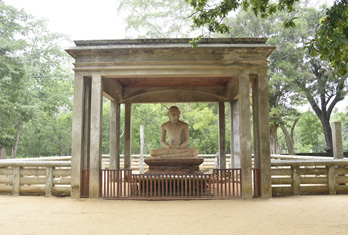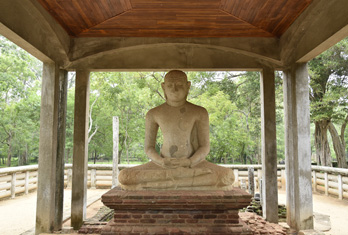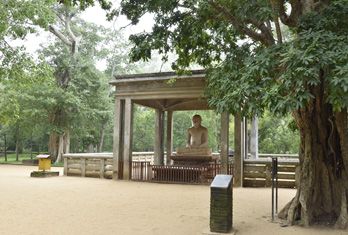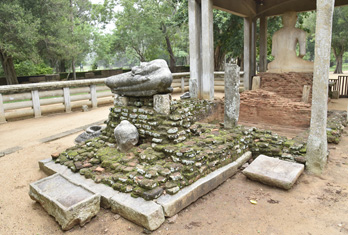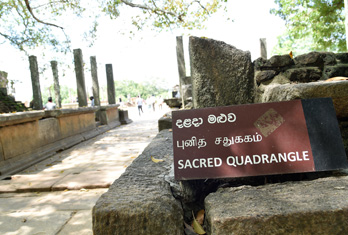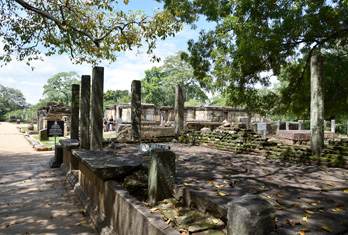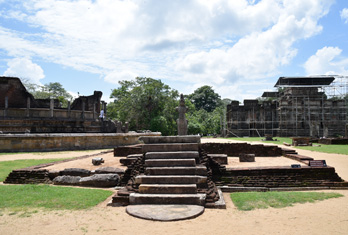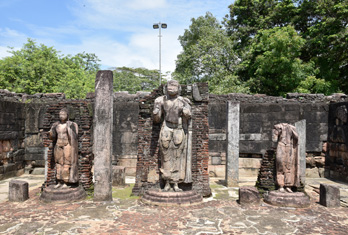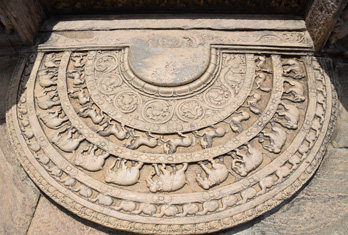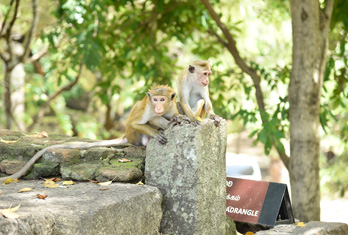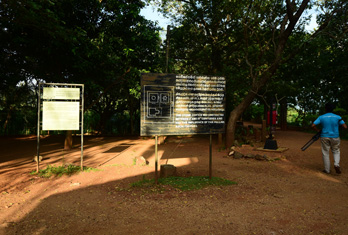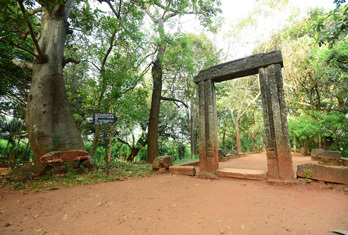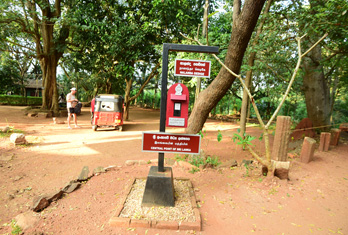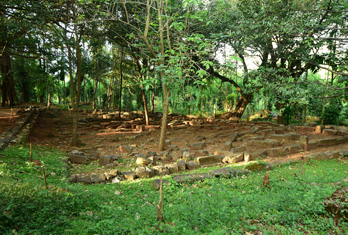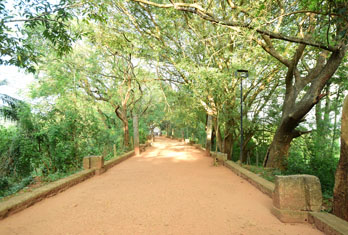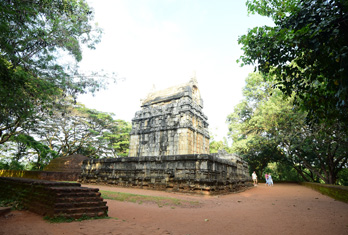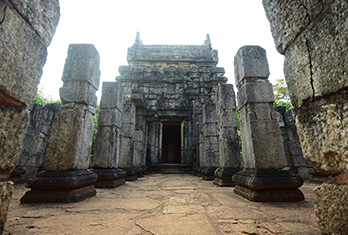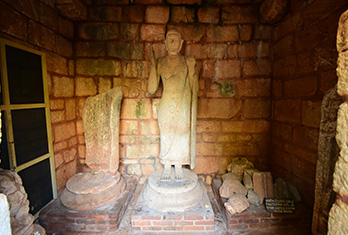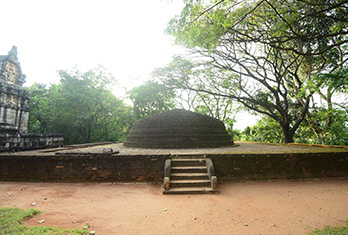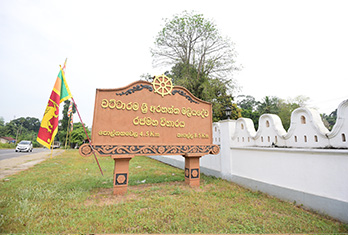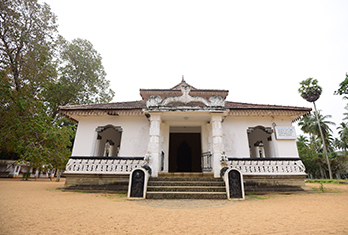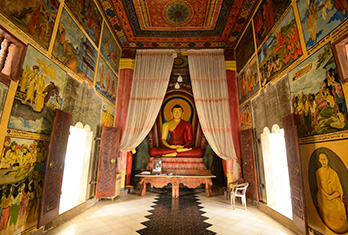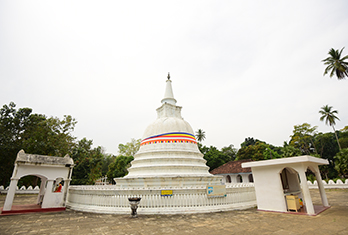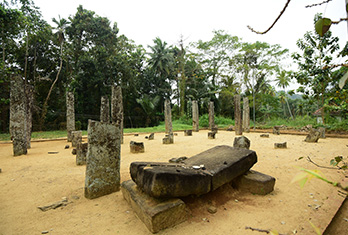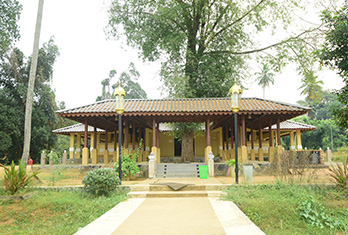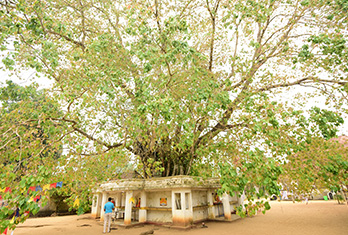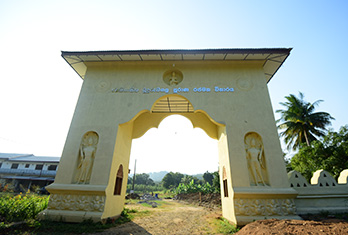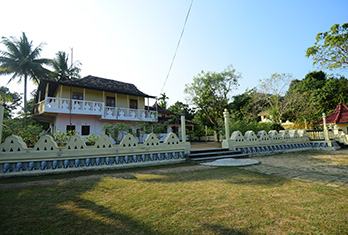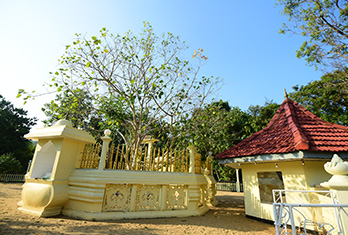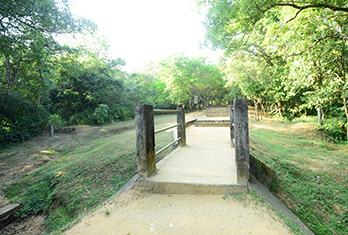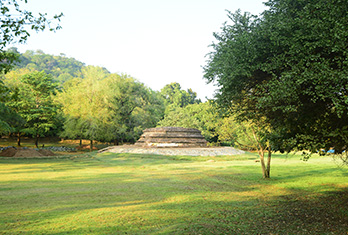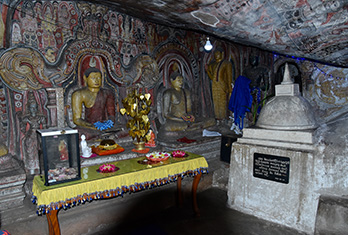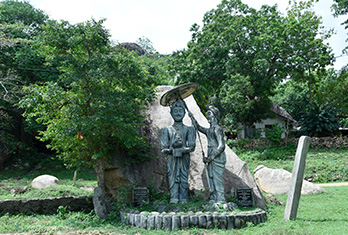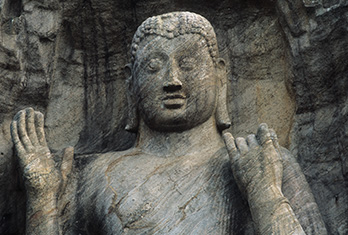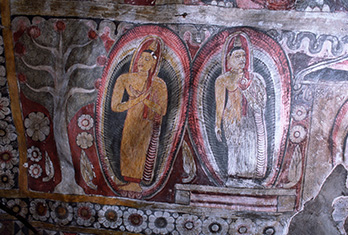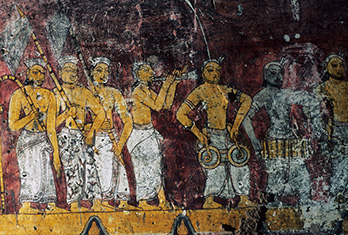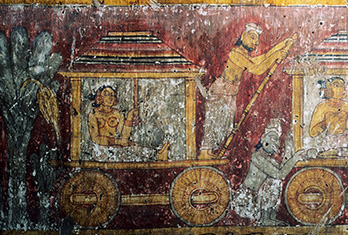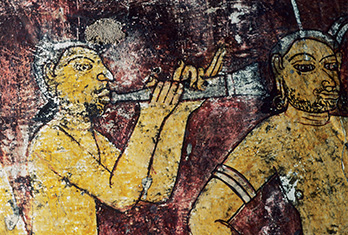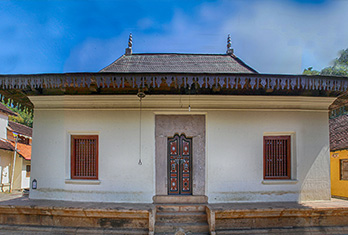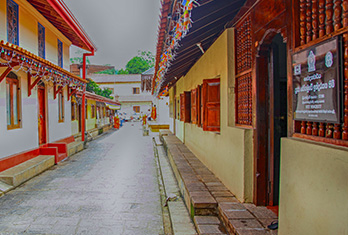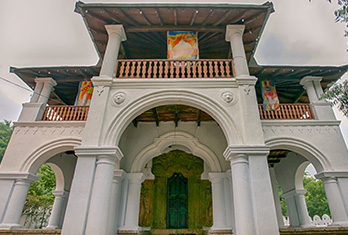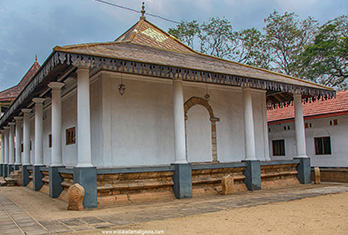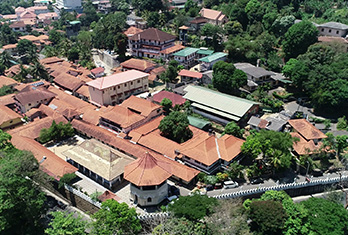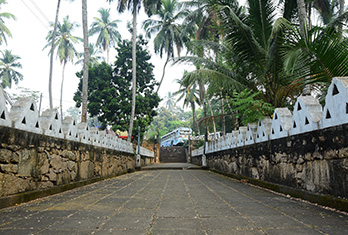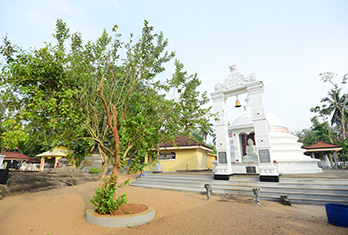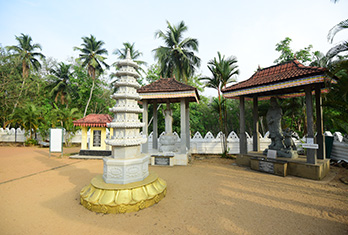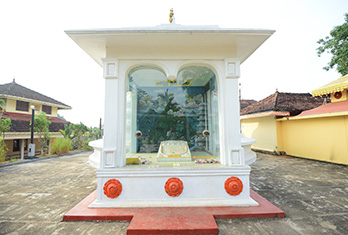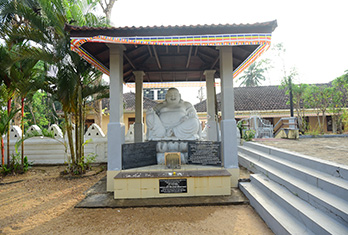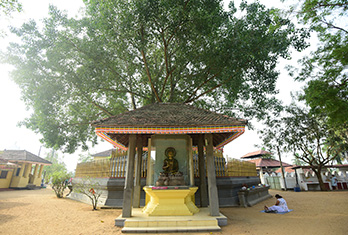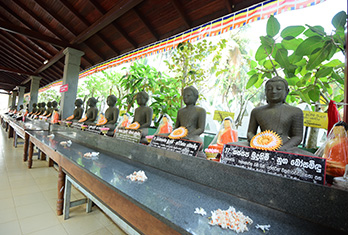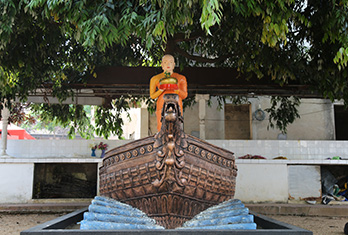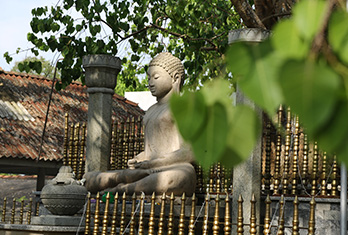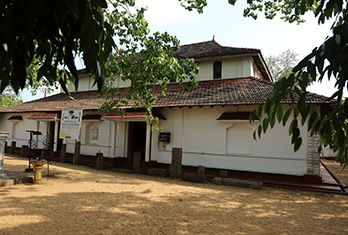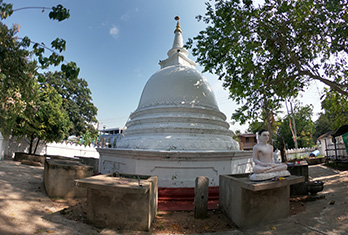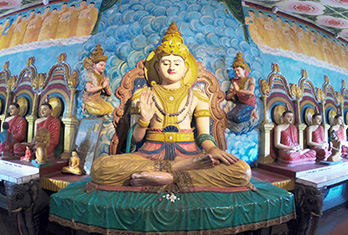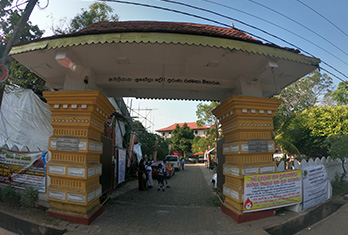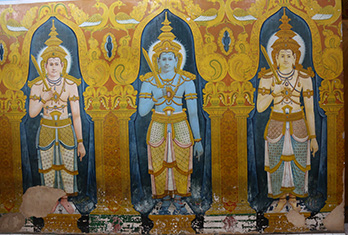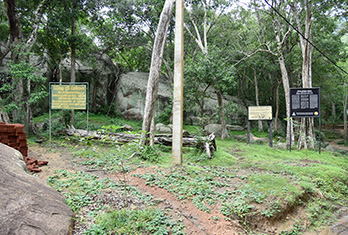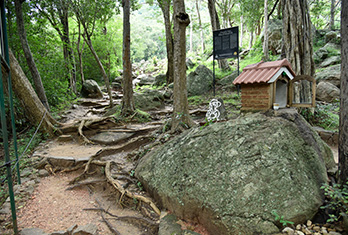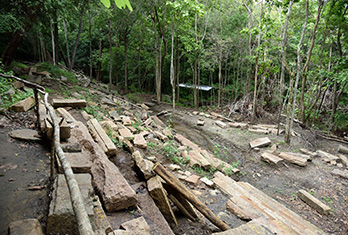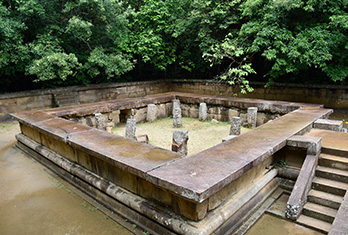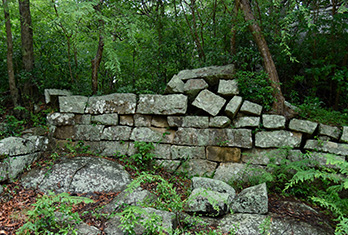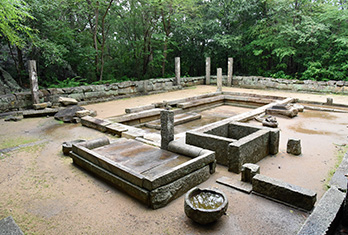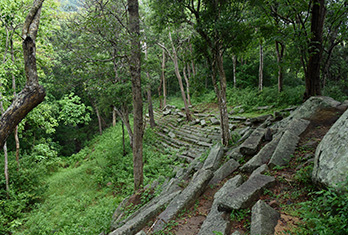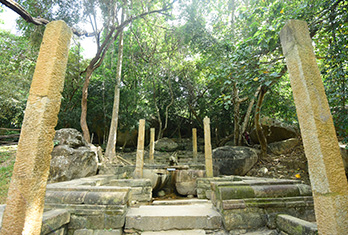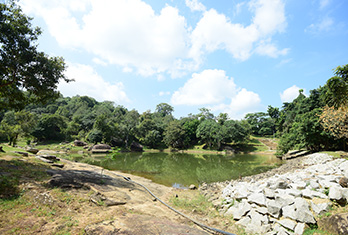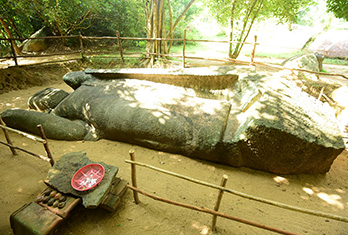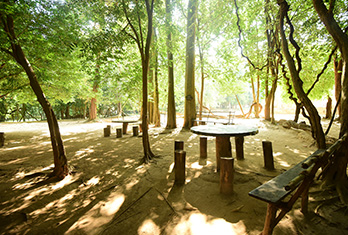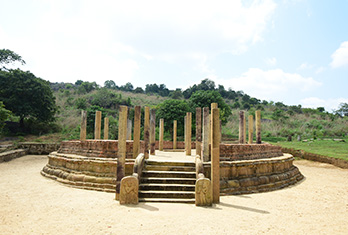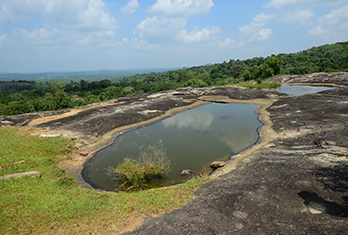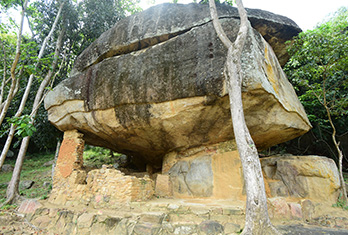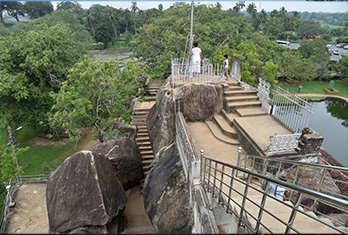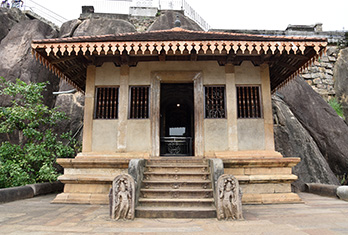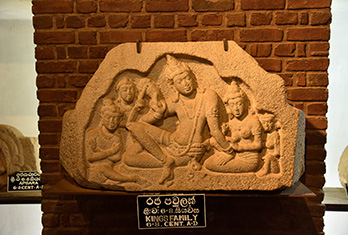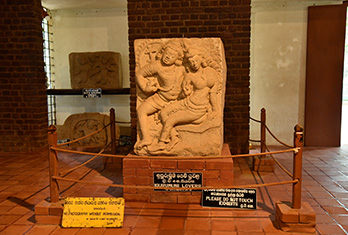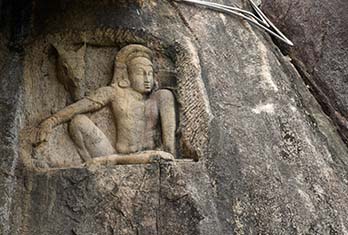Temple of the Sacred Tooth Relic (Dalada Maligawa)
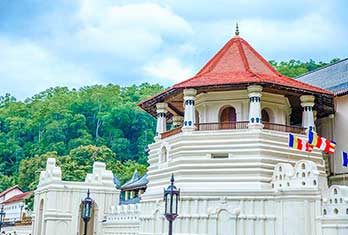
Temple of the Sacred Tooth Relic or Sri Dalada Maligawa is situated at the ancient royal palace complex in Kandy. The Buddha’s Sacred Tooth Relic was brought to Sri Lanka by Prince Dantha and Princess Hemamala during the period of King Keerthi Sri Megawarna in 4th century ACE.
The Sacred Tooth Relic became a palladium of Sri Lankan rulers and it was vitally protected in a special shrine built near the royal residence in Kandy. Dalada Maliwaga in Kandy was built by King Wimaladarmasooriya I in 1592 CE. The Temple’s Palle Viharaya was built by King Keerthi Sri Rajasinghe and the Paththirippuwa (octagon) was built by King Sri Wickrama Rajasinghe.
The sacred city of Kandy was declared as a UNESCO world heritage site in 1988 because of the historical value of the Temple of the Sacred Tooth Relic. All arts and architecture in the Temple premises belong to Kandyan style. The main entrance of the Temple is called Mahawahalkada. There is a beautifully carved moonstone (Sandakadapahana) at the entrance.
Sri Maha Bodhi
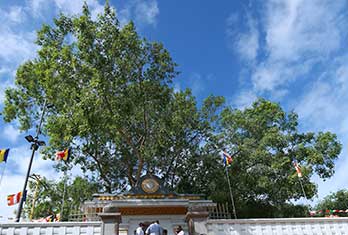
The sacred Siri Maha Bodhi in Anuradhapura is considered as the the oldest historical tree in the world. It was brought to Sri Lanka by Theree Sangamitta and planted in the Mahameghawana at Anuradhapura by King Devanampiyatissa under the guidance of Arahant Mihindu Maha Thero.
It was a branch of the Jaya Sri Maha Bodhi at Buddhagaya where Lord Buddha was sat in Meditation when he attained supreme Buddha hood. This was a spiritual gift to king Devanampiyatissa by the Emperor Asoka on the request of his son Arahat Mahinda. This tree belongs to the family of trees known as ‘asvastha’ in Sanskrit, ‘asvattha’ in Pali, ‘aesatu’ in Sinhala. Many rulers in Sri Lanka have contributed in developing and renovating this sacred place such as King Vasabha, King Voharika Tissa ,King Mahanaga and King Sena II .
Kelaniya Raja Maha Viharaya
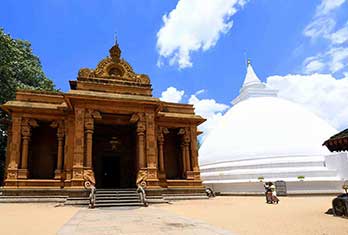
Kelaniya Raja Maha Viharaya is located in Kelaniya in the Gampaha District. Kelaniya Temple is a scared place dedicated to the Buddha’s third and last visit to Sri Lanka. According to historical evidence, after eight years of the Buddhha’s Enlightenment, he visited Kelaniya on the invitation of Naga King Maniakkhitha.
The Mahawamsa records that the original stupa at Kelaniya enshrined a gem-studded throne on which the Buddha sat and preached. Thus, the history of the temple dates back to 500 BCE. Kelaniya Temple is also famous for its murals which were done by the well-known artist Solias Mendis. The murals depict the history of the temple and other Jathaka stories related to the Buddha’s life.
Lovamahapaya (Brazen Palace)
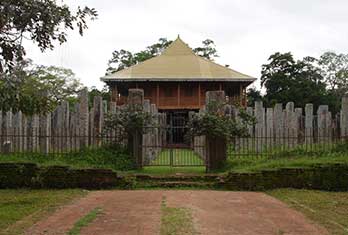
Lovamahapaya or the Brazen Palace is one of the eight sacred places of Anuradhapura. It is located between the sacred Bodhi-tree and Ruvanweli stupa in the Mahamegha grove of Anuradhapura. It was constructed in the 2nd century BCE by King Dutugamunu as a massive nine storied mansion. This was named as “Lovamahapaya” at that time itself as its roof was covered with Metallic tiles, hence the English name Brazen Place. During the reign of King Saddhatissa , sucseeor of its builder , Lovamahapaya was destroyed by an accidental fire. Then it has been reconstructed by the King as a seven stories building. It is said that Lovamahapaya was demolished by the king Mahasena in the 3rd Century CE but later reconstructed by his successors.
Lankaramaya
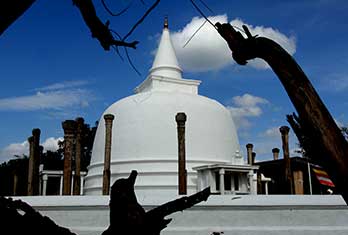
Lankaramaya is one of the eight sacred places at Anuradhapura, located in between the ancient citadel and Abhayagiriya stupa. It was built as a Vatadage or a round shaped Chathiyaghara. The stupa has been reconstructed in late 19th century and remains of the Chathiyaghara are still retains as stone pillars around the stupa.
Abhayagiri
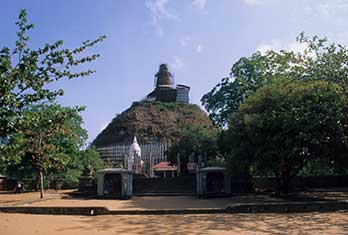
Abhayagirya is one of the three major monastic complexes of Anuradhapura. Abhayagiriya has a huge stupa and several monasteries including thousands of monuments. The stupa of the Abhayagiriya Monastery was constructed by King Valagambahu in the 1st century BCE after demolishing a Jain monastery at the site.
Jethawanaramaya
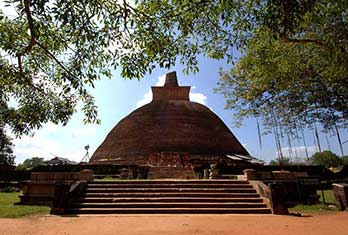
Jethavanarama Monastery Complex is located to the East of Ruwanveliseya and was developed around Jethavana Stupa which is considered as the highest stupa in the world. The stupa was constructed by King Mahasena in 3rd century CE and is presently considered as one of the Eight Sacred Places in Anuradhapura.
Mihintale
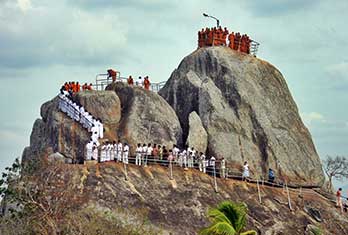
Mihintale is considered as the cradle of Buddhism in Sri Lanka. It is one of the most attractive pilgrim sites in Sri Lanka. It is one of the Eight Sacred Places of Anuradhapura, though it is located about 11kilometers away from Anuradhapura City. Mihintale is highly venerated as the place where Arahat Mahinda Thera came to Sri Lanka and lived several years as a founder of Buddhism in Sri Lanka.
The name Mihintale is named after Arahat Mahinda Thera. It is also known as “Sagiriya” or “Chethiyagiriya” as there were many stupas at Mihintale. According to Mahawamsa, King Devanampiyatissa of Anuradhapura met Arahat Mahinda Thera at Mihintale in 3rd century BCE. The place where he met at Mihintale is considered as the place where the Ambastala stupa is located at present.
Mirisawetiya
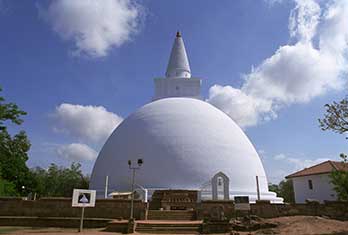
Mirisavetiya stupa and the monastery around it is a part of the Mahavihara Complex of Anuradhapura. Mirisavetiya stupa is also one of the Eight Sacred Places in Anuradhapura. It was constructed by Kind Dutugamunu in the 2nd century BCE by enshrining his scepter and relics of the Buddha. According to legends, King Dutugamunu constructed this stupa as a punishment (to himself) for having a chilly curry without bestowing it to the Maha Sangha (as was his usual practice).
Ruwanveliseya
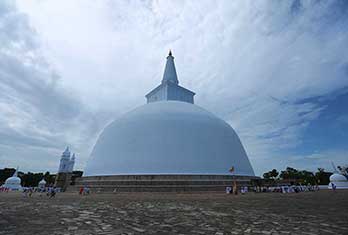
Ruwanveliseya is one of the most significant religious places for Buddhists and it is one of the Eight Sacred Places in Anuradhapura. It is the principal monument of Mahavihara Complex of Anuradhapura and is situated between the Sri Maha Bodhi Tree and Thuparama Stupa. Ruwanveliseya was constructed by King Dutugamunu in the 2nd century BCE. The great chronicle Mahawamsa refers to Ruwanveliseya as the “Maha Thupa”. According to legends, there was a tree consecrated to a tree-sprit known as “Swarnamalee” at this point before the stupa was constructed. Hence, the stupa was also named as “Swaranamalee Maha Chetiya”.
Sela Cetiya
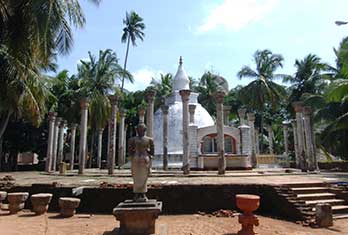
Sela Cetiya is one of the 16 main places of worship, otherwise known as one of the ‘Solosmasthana’. It is situated to the west of Jethavanaramaya in the ancient sacred city of Anuradhapura, Sri Lanka.
The Sela Cetiya was constructed by ‘King Lajjitissa’ who ruled in the 1st century BC. The diameter of the base of the stupa is 37 ½ feet’s. This stupa has been given this name as the platform and stupa has been constructed in stone. A moonstone and guardstones can be seen here.
‘Solosmasthana’ are 16 sacred places in Sri Lanka, believed by Buddhists to have been hallowed by visits of Lord Buddha. These places of worship are among the most important religious locations in Sri Lanka, while ancient historical scripts reveal that Lord Buddha visited the country on three occasions.
Thanthirimale Rajamaha Viharaya
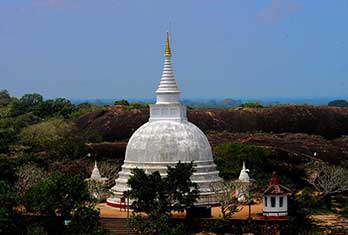
Thanthirimale Rajamaha Viharaya is located at Anudradhapura District of the North Central Province. It is situated 47 kilometers off Anuradhapura on the Anuradhapura-Vilachchiya Road. Thanthirimale is significant as there are pre-historical and historical remains including a large Buddhist Monastery.
Thuparamaya
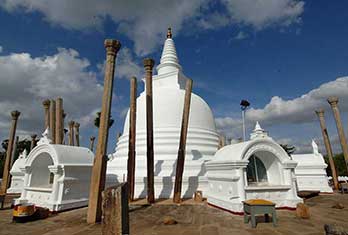
Thuparama stupa is the first stupa constructed in Sri Lanka after Buddhism was embraced as the state religion . It is one of the Eight Sacred Places in Anuradhapura. This was constructed by King Devanampiyatissa on the request of Arahat Mahinda Thera in 3rd century BCE. It is located to the North of Ruwanveliseya and in close proximity to Basawakkulama Tank on one side and the citadel on the other side.
Avukana Buddha Statue
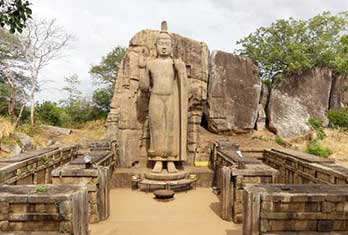
Avukana is well known for the Buddha Statue of the monastery found by the same name near Kalawewa in the Anuradhapura District. This statue is a rock cut image of standing posture of 11.36 meters high and stand on a lotus pedestal.
Deegawapi Rajamaha Viaharaya
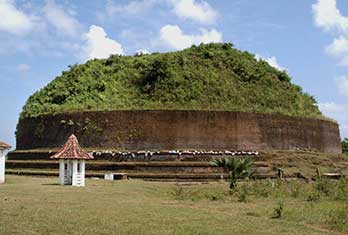
Raja Maha Viharaya of Deeghavapi is located in the Ampara District of the Eastern Province. This is considered as one of the Sixteen great places of Buddhists in Sri Lanka. According to Mahavamsa, the stupa of Deeghavapi monastery was constructed by King Saddhatissa with a jacket decorated with golden lotus flowers and gems in the 1st century BCE. The place where the stupa was located is considered as the place where the Buddha spent some time with Arahat s absorbed in ecstatic meditation during his final visit to Sri Lanka.
Dowa Rajamaha Viharaya

The Raja Mahe Viharaya at Dova is located a few Kilometers away from Bandarawela town on the Bandarawela - Badulla road in Uva province. This temple is believed to have been constructed by King Valagamba in 1st century BCE.
Mahiyangana Rajamaha Viharaya
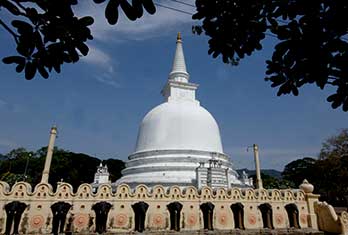
Mahiyangana Raja Maha Viharaya is situated near the Mahaweli River at Mahiyanganaya in the Badulla District. Earlier, Mahiyangana Stupa was known as Miyuguna Seya. The Temple was named as an archaeological protected monument on 22nd of November 2002. Mahiyangana Raja Maha Viharaya is one of the 16 scared places (Solosmasthana) in Sri Lanka. According to historical records, Mahiyanganaya was considered as a sacred place as the Buddha made his first visit to Sri Lanka after nine months of the Enlightenment. When the Buddha arrived at Mahiyangana, the Yakkhas (one clan of the original inhabitants in Sri Lanka) were living here.
Muthiyangana Rajamaha Viharaya at Badulla
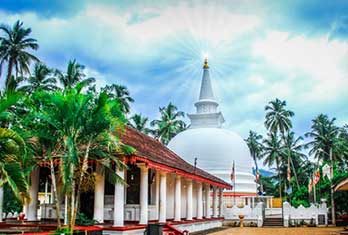
Muthiyangane Raja Maha Viharaya is located in the Badulla District of Uva Province. According to legends, this was one of the places where the Buddha stayed with other Arhath monks during his third visit to Sri Lanka.
Bellanwila
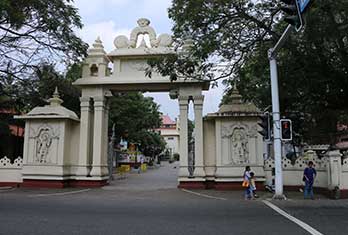
Bellanwila Rajamaha Viharaya is a scared Buddhist temple in the Colombo district. Historical evidences reveal that the Bodhi tree of the temple is one of the 32 saplings that sprang from Sri Maha Bodhi tree at Anuradhapura and it was planted in 3rd century BCE. Thus, the history of Bellanwila Temple dates back to King Devanampiyatissa’s era. The Temple was abandoned after Portuguese invasion of Sri Lanka. It was rediscovered by a monk known as Ven. Thengodagedara Thera. Other than the Bodhi tree , a stupa, an Image House with elegant paintings and dwelling house of monks can be seen in the temple premises.
Colombo Gangaramaya Temple
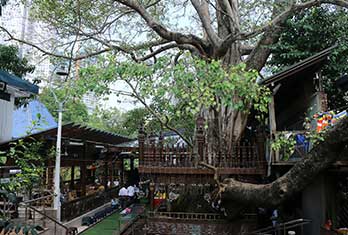
Gangaramaya is one of the first modern temples in the Colombo District located near the Beira Lake in the Colombo City. It was established by Ven. Hikkaduwa Sri Sumangalka Thera in late 19th century. The temple architecture and design have been influenced by Sri Lankan as well as various other countries such as Thailand, China and India. Bo tree, stupa, chamber of relic and Seema Malakaya are the main features of the temple. Seema Malakaya was designed by the famous architect, Geoffrey Bawa in 1979. The temple has a great collection of Buddha Statues, artifacts, relics of the Buddha, ancient coins and old motor vehicles. The museum and the library of the Temple are located within the temple premises.
Kotte Raja Maha Viharaya
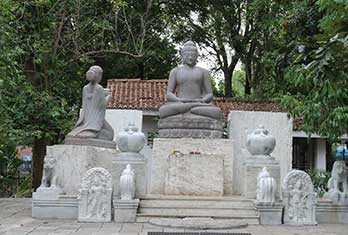
Kotte Raja Maha Viharaya is an ancient Buddhist temple located in Sri Jayawadhanapura Kotte near the Colombo City. This temple was declared as an archeological site by the Government on 17th May 2013. The chief incumbent of the temple is Ven. Aluthnuwara Anuruddha Thera. King Parakramabahu VI built this temple in 15th century CE closer to his palace with the intention of carrying out offerings to the Sangha community.
Mahamewnawa
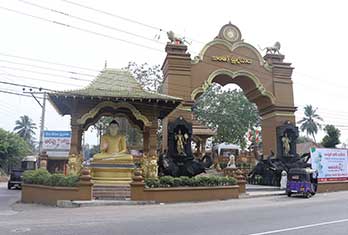
Mahamevnawa Buddhist Monastery is a place for everyone, regardless of the country they hail from or even if they are a Buddhist or not. Here resident will discover like-minded community of people who are interested in finding happiness that is not based on endless consuming and accumulating more and more things.
By learning and practicing the teachings of the Lord Buddha, you will gain a peace and happiness that is not tied to the ups and downs of ordinary life.
Sithulpawwa Rajamaha Viharaya
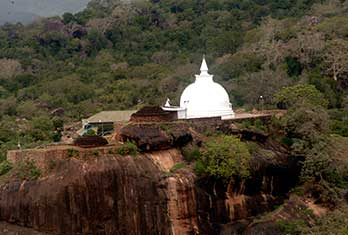
Sithulpawwa is a monastic site located at the Yala National Park in Hambanthota District near the South-east coast. This ancient monastery complex is situated 24 kilometers away from Tissamaharama along the Tissa - Situlpawwa Road. This monastery has been identified as an ancient “Chittalapabbatha” vihara established by King Kawantissa of Tissamaharama in the 2nd century BCE.
Tissamaharama Rajamaha Viharaya

Tissamaharama Raja Maha Viharaya is at Tissa in the Hambanthota District of the Southern Province. It is one of the 16 sacred places to Buddhists in Sri Lanka as it is considered as one of the places where the Buddha visited. The stupa in the Thissamaharama Raja Maha Viharaya is the largest stupa of the Rohana Kingdom in the south of Sri Lanka.
Dambakolapatuna Viharaya
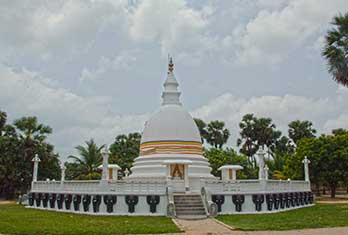
Dambakolapatuna or Jambukola Pattana is an ancient port in the north of Jaffna near Kankesanthurai. According to Mahawamsa, Theri Sangamitta landed at Dambakolapatuna with the sapling of the Sacred Bodi tree in the 3rd century BCE. King Devanampiyatissa of Anuradhapura has gone to Dambakolapatuna to receive Theri Sangamitta and escorted her to Anuradhapura in a ceremonial pageant.
Nagadeepa Rajamaha Viharaya
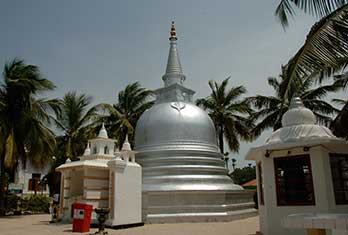
This temple is located in “Nainativu” or Nagadeepa Island off Jaffna peninsula. Nagadeepa Island can be reached by boat in 30 minutes from Jaffna. According to legends, the Buddha has visited Nagadeepa Island in his second visit to Sri Lanka to settle the quarrel between two Naga Kings over a gem plaque and it is believed that the gem plaque was enshrined at the Nagadeepa stupa.
Kande Viharaya
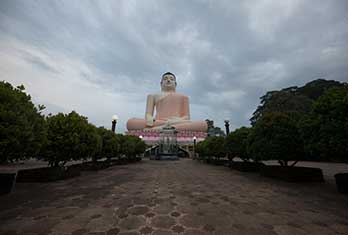
Kande Viharaya is situated at Aluthgama in the Kalutara District. It got its name as it is constructed on top of a hill (hill meaning Kanda in Sinhala). It is one of the archaeological protected monuments in the Kalutara District. It was constructed by Ven. Karapagala Dewamitta Thera in 1734, under the guidance of Ven. Udugama Chandrasara Thera and Ven. Dedduwa Dhammananda Thera. Kande Viharaya is famous for its large Samadhi Buddha statue depicting the Bhoomisparsha Mudra. It is one of the largest sitting Buddha statues that was recently constructed in Sri Lanka. It is 48.8 m (160 ft) in height. The temple premises consist of a stupa, Bo tree, Image House, relic chamber and several devalas dedicated to Gods Upulvan, Kataragama and Paththini.
Kalutara Bodhiya
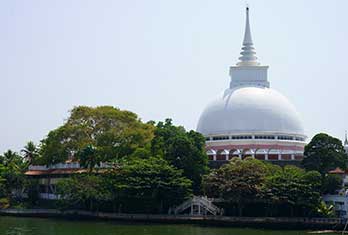
Kalutara Temple is situated near the bridge of the Kalu Ganga in the Western Province. The Temple was previously known as Gangathilaka Viharaya. As a practice, people who go passing the Temple seek blessings by paying homage to the Bo tree of the Temple for a safe journey.
Kalutara Bodhiya is considered as one of the 32 saplings of the Sri Maha Bodhi planted during King Devanampiyatissa’s period in the 2nd Century BCE. The stupa of the temple was built in 1970. It was built according to a unique architectural style. There is another small stupa inside the main stupa with Buddha statues around it.
There are murals inside the stupa. The stupa was commissioned by Sir Cyril de Zoysa with the design undertaken by Justin Samarasekera in collaboration with A. N. S. Kulasinghe.
Degaldoruwa Rajamaha Viharaya
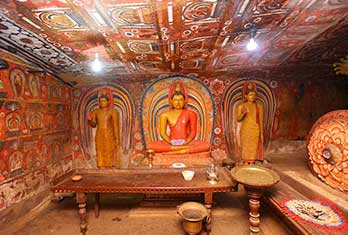
Degaldoruwa Rajamaha Vihara is at Degaldoruwa near Kundasale in the Kandy District. According to history, this cave was used by King Kirti Sri Rajasinghe as his residence while he constructed the Galmaduwa Vihara. He had devoted his attention to develop the cave as a Rajamaha Vihara. The principal monument of this Rajamaha Vihara is the Image House accommodated in a cave.
Gadaladeniya Rajamaha Viharaya
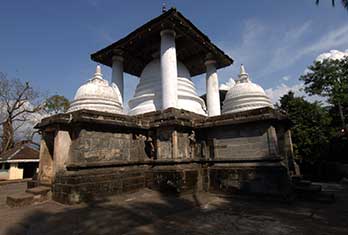
This temple is located at Gadaladeniya village at Udunuwara in the Kandy district. It can be reached from Colombo - Kandy Road by turning towards Daulagala at Embilimigama junction. An inscription found at the temple mentioned that the vihara and devala complex were constructed in the 3rd year of King Buwanekabahu IV and the architect was a person named Ganeshwaraji who seemed to be a South Indian craftsman.
Lankathilaka Rajamaha Viharaya

Lankathilaka Viharaya is one of the main temples constructed during the mediaeval period in Sri Lanka. It is situated in Udunuwara in the Kandy district. The history of the temple goes back to the 14th century CE. According to historical records, Lanakathilaka Viharaya was built by King Buvanekabahu who ruled the Gampola Kingdom from 1341 to 1351 CE. Lankathilaka Viharaya is considered as the most magnificent architectural edifice constructed during the Gampola Period. According to historical records, this temple was built as a four storied building at a height of 80 feet. At present, it has only three stories. The design and architecture of the Lankathilaka Viharaya were done by south Indian architect Sathapai Rayer.
Athkada Rajamaha Viharaya
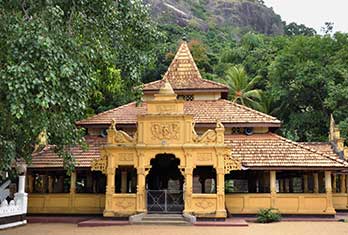
Athkada Viharaya is at Kurunegala town of North Western Province. It is believed that the temple was built by King Suratissa, a brother of King Devanampiyatissa in the 3rd century BCE. This is a cave temple at the foot of Athgala, the massive rock of Kurunegala town.
Wijayasundararamaya, Dambadeniya
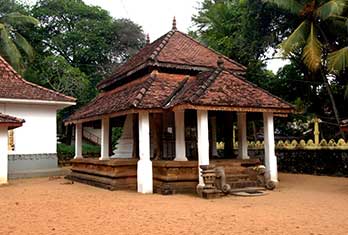
The Tampita Viharaya at the Sri Wijayasundararamaya is believed to be the ancient relic house of the Dambadeniya Kingdom. Tampita Viharaya found on this terrace has been identified as the Relic House which is a three storied building constructed by King Parakramabahu II (1244 -1279), son of Vijayabahu III.
Rambodagala Buddha Statue
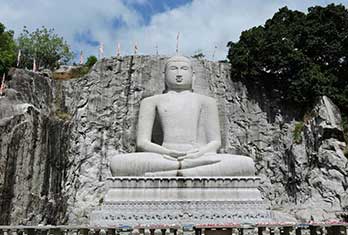
Monaragala Temple at Rambodagalla in the Kurunegala District is a modern temple popular among pilgrims. It was constructed within the last two decades. The temple is about 20 kilometers away from Kurunegala and only 5 kilometers from Ridi Viharaya along the Rideegma - Keppetigala Road.
Ridi Viharaya
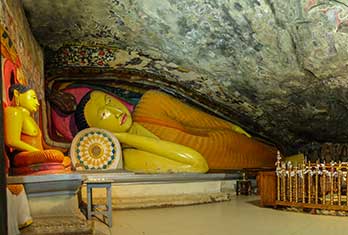
Ridi Viharaya is at Ridigama in the Kurunegala District of North Western Province. It lies about 20 kilometers away from the Kurunegala town. This temple is considered as the place where silver (Ridi) ore was discovered when King Dutugamunu built Ruwanwelisaya at Anuradhapura. It is said that the discovery was auspicious and the opportunity of finding meritorious works of King Dutugamunu. Hence, silver discovery from this place was granted to the construction work of the stupa.
Kataragama Kiri Vehera
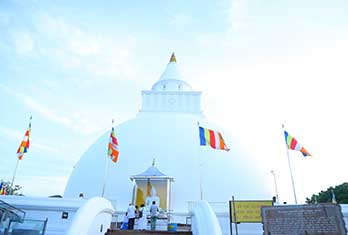
Kirivehera is situated in Katharagama, in the Monaragala District. It is one of the 16 sacred places in Sri Lanka. It is believed that Kirivehera was built by King Mahasena. He was a regional ruler of Katharagama. It is said that King Mahasena met the Buddha and listened to the Buddha’s discourse and as a token of gratitude the stupa was constructed.
Alu Viharaya Temple
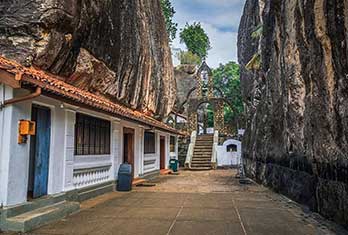
Aluvihare or Aloka Vihare is situated about four Km north of Matale Town on the Matale – Dambulla road. It is well known site as it was the place where Pali Tripitaka was first committed to writing in the 1st Century BCE during the reign of King Valagambahu. Remembering this historic legacy, the monks of the temple still practicing copying of Buddhist scriptures in palm leaves at the temple premises. This is a picturesque place with full of boulders and rock shelters.
Dambulla Cave Temple
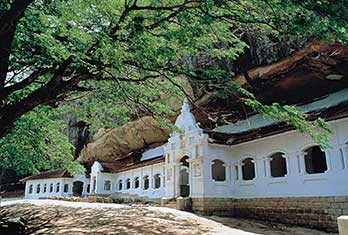
Dambulla Cave Temple (also known as Dambulla Golden Temple) is the largest and well-preserved cave complex in Sri Lanka located in the Matale district. Dambulla Golden Temple was declared as a UNESCO World Heritage Site in 1991. It is believed that King Walagamba converted this cave complex into a temple in the 1st century BCE after regaining power from South Indian invaders. There are five shrines in the cave trample:
Pidurangala Rajamaha Vihara
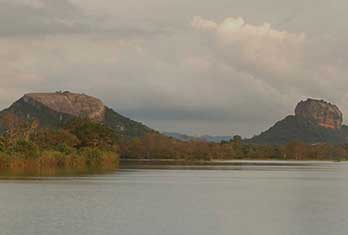
Pidurangala Raja Maha Viharaya is located in the Matale District close to the well-known site Sigriya. The history of Pidurangala goes back to the 1st and 2nd century BCE. Therefore, Pidurangala was used as a monastery from ancient time. During the reign of King Kasyapa this place became a prominent Buddhist Monastery. Therefore, it is believed that the "Uppalavanna Kashyapa Giri Viharaya" which was constructed by King Kashyapa was located in Pidurangala.
Devinuwara Rajamaha Viharaya
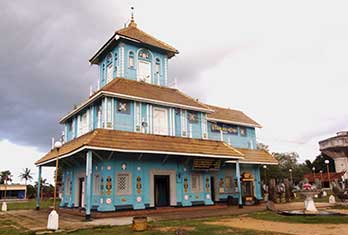
A white and modern archway and a gravel path give way to a temple beckoning its visitors to the sacred ground of Dewundara Dewalaya. The origin of the Dewalaya, is beautifully described in the poem ‘Panditha Perakumba Siritha’. According to legend, ‘King Dappula’ I of Anuradhapura, once dreamt of an unusual dream, in which he was told of the arrival of ‘Upulvan Deviyo’ in the form of a ‘kihiri’ log (a type of wood) at Dewundara. Believing that the dream meant something, the very next day the King and his entourage went down to the shore of Devi Nuwara and lo and behold there was a ‘kihiri’ log. The log was at once taken in to the custody of the King and was carved in relief of the deity. It was then ceremonially enshrined within the Dewundara Dewalaya.
Veherahena Viharaya
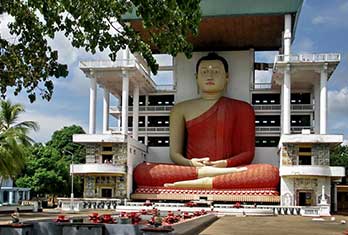
Veherahena Temple is situated in the Matara District. Even though, this temple does not have a long historical and archeological background, it is famous among devotes because of its special features. It is mentioned that Veherahena is the largest and first tunnel temple in the world. The founder of the temple was Ven. Parawahera Rewatha Thera in early 20th century. Ven. Rewatha Thera was sent to this area as a punishment by his teacher. With the help of the villagers, Ven.
Alahana Piriwena
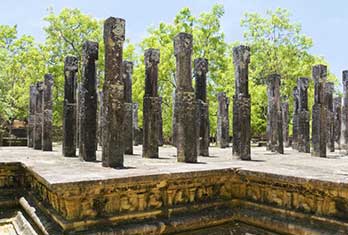
The Alahana Pirivena is located between the Northern entrance of the city and the Galvihara Monastery of ancient Polonnaruva City. The monastic complex was constructed by King Parakramabahu the Great in 12th century CE. It was developed as a huge Buddhist University where thousands of Buddhist monks were educated during that time.
Gal Viharaya
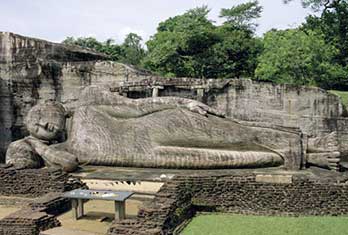
Gal Viharaya is possibly the most attractive place among ancient monuments at Polonnaruva. It is located north to Alahana Pirivena and South to Demala Maha Seya of the Ancient city of Polonnaruva. Gal Viharaya is known as “Uttararama”, meaning “Northern Monastery” which was built by King Parakramabahu the Great in the 12th century CE. This Temple comprises three large rock cut Buddha Images and a cave with a small Buddha Statue. Among three Buddha Statues, the recumbent Buddha Statue represents Maha Parinibbana or demise of the Buddha.
Rankoth Viharaya
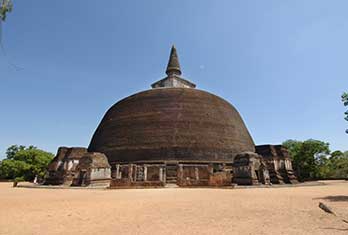
Rankoth Viharaya at Panadura in the Kalutara District is one of the well-known Buddhist temples in Sri Lanka. This temple was established in 1810 by Ven. Batapola Kalyanatissa Thera, the chief disciple of the Most Venerable Sri Kataluwe Gunaratana Mahanayaka Thera. According to history, this temple was set up in a small hut in a quarry at Panadura. Therefore, the temple was known as the Galwale Pansala meaning “The temple in the quarry” and later it was called as Galkande Vihara.
Somawathi Stupa
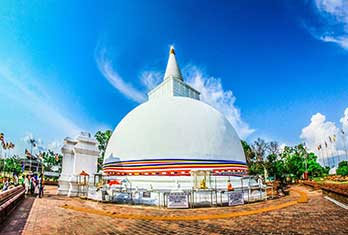
Somawathi stupa is located in the Polonnaruva District of the North Central Province. It was built in the 2nd century BCE at the bank of river Mahaweli. According to historical sources the right Tooth Relic of the Buddha was enshrined at this stupa. It was constructed by King GiriAbha.. This stupa was named after Princess Somawathi, the sister of King Kawanthissa who was married to Prince Abhaya.
Sri Pada mountain
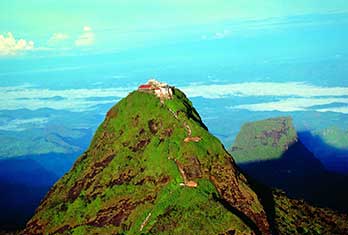
The Sri Pada or Samanala Mountain is the holiest mountain in Sri Lanka. It is also known as the Adam’s Peak by the Western writers. The mountain is 7400 ft high from the mean sea level and boarders Ratnapura and Nuwara Eliya Districts. The summit of the mountain is the point of attraction as it contains the foot print (Sri Pada) of Lord Buddha. There is a temple for practicing rituals besides the Foot Print. This is an annual pilgrim site of Buddhists and considered as one of the great sixteen sacred places in Sri Lanka. Two main routes, one via Ratnapura and the other via Hatton are being used presently to climb the mountain. One of the interesting aspects of Sri Pada is that it was considered as a holy place not only by Buddhists but also by Christians, Hindus and Muslims and they also make pilgrims to the mountain.
Girihaduseya (Nithipathpana) at Thiriyaya
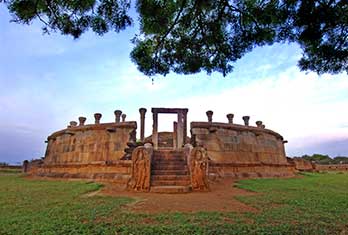
Girihaduseya is located at Thiriyaya in the Trincomalee District of the Eastern Province. Girihaduseya is believed to be the first stupa in Sri Lanka which was constructed by Thapassue and Balluka Merchants during the life time of the Lord Buddha. This stupa is also known as Nithipathpana. During ancient times, this stupa was known as “Girikanda stupa”. It is believed that in Girihadu stupa the hair relic of the Buddha is enshrined.
Seruvila Mangala Raja Maha Viharaya
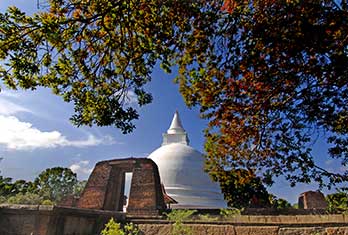
Seruvila Mangala Rajamaha Viharaya is an ancient Buddhist Temple located in the Trincomalee District. It is one of the 16 holiest Buddhist sites (Solosmasthana) in Sri Lanka. This temple was constructed during the period of King Kavantissa in the 2nd century BCE. In 1922, Seruvila Stupa was rediscovered by Ven. Dambagasare Sumedhankara Thera. Thereafter, its conservation and reconstructions were commenced.
Yapahuwa Kingdom of Ancient Sri Lanka
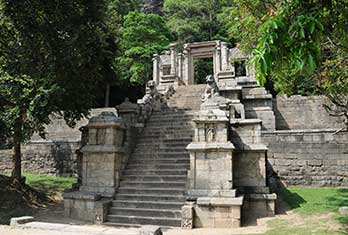
Yapahuwa was once Sri Lanka’s seat of governance and home to the Sacred Toot relic of the Buddha. Today it is one of the most unique and historic sites in the country. It is also home to the singular Chinese looking Yaphauwa Lion. The image is reproduced in the country’s Rs. 10 note. Historians compare the Yapahuwa to the Sigiriya rock fortress but denote that it was built on a smaller scale.
Diwaguhawa
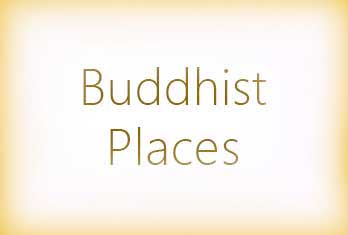
When the lord Buddha had visited Sri Lanka, he also paid his blessings on the Adam's peak, mostly known as Sri Pada. On the way back, due to fatigue, he rested with 500 other monks in a cave. He did it in the noon time and hence the name of this temple which is known as Divaguhawa (the cave of the noon).
After that, King Nissankamalla from the Polonnaruwa era had built a Buddha statue here. For a while there had been no one to attend to this or maintain it and soon it become a part of the jungle. According to a myth, during King Nissankamalla’s time, he was visited by King Lambakarna from India and was accompanied by a group of wives. One of his wives was so fond of the king but the others got together and spoke ill of her. The king killed her but it is said that she was born as a demon and is said to live in this cave.
Samadhi Buddha Statue
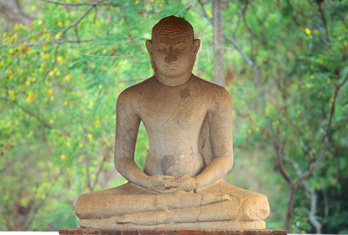
Samadhi Buddha Statute at Anuradhapura is considered as the finest Buddha Image of Sri Lanka. It is found between the stupa and the twin ponds of the Abhayagiriya Monastic Complex. This Buddha Image is in Virasana seating posture. This statue was originally covered in colour plaster and its eyes were studded with gems.
Jawaharlal Nehru, the first Indian Prime Minister said that he obtained solace by looking at a photograph of this Buddha Statue when he was imprisonment by the British during the time of Indian Independent Struggle.
Dalada Maluwa , Polonnaruva
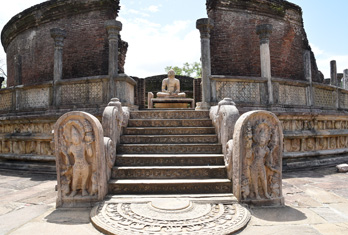
The Sacred Quadrangle or the Dalada Maluwa at Polonnaruva is a complex of religious monuments belonging to the period of Polonnaruva Kingdom. It is located to the North of the citadel and south of Alahana Parivena of the ancient city of Polonnaruva. Further, it is situated a few feet higher than the ground level and has the main entrance in the east and an exit gate provided in the west.
Dalada Maluwa was originally constructed by King Vijayabahu I and developed by successive Kings of Polonnaruva Kingdom.
Nalanda Gedige
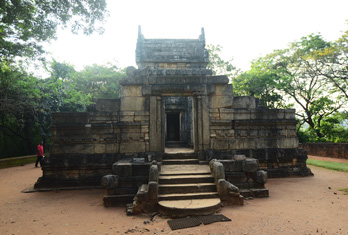
Nalanda Gedige is located at the Matale District of the Central Province. Due to the architectural type and features, this shrine is known as “Nalanda Gedige”. This Gedige shrine is a blend of Buddhist and Hindu architecture and is entirely built of stone. There are few Buddha statues at Nalanda Gedige and the figure of Ganesha and Bodisatva figures are housed in the shrine. There are also bas-reliefs.
Wattarama Raja MahaViharaya
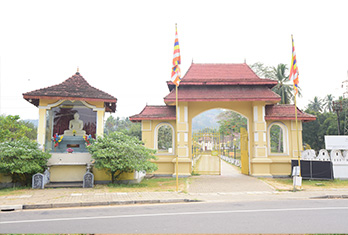
Wattarama Raja Maha Vihara is located at the Kegalle District of the Sabaragamuwa Province. According to Mahabodhivamsa, one of the 32 saplings of the sacred Bo-tree at Anuradhapura had been planted at this temple. Further, this temple is believed as the place where Arhat Maliyadewa Thero (the last Arhnt Thero of Sri Lanka) has lived.
Sankapala Raja Maha Viharaya

Sankapala Rajamaha Viharaya is located at Pallabedda in Ratnapura district. This temple contains fourteen caves and three of them have Early Brahmi inscriptions. According to the legends, Pussadeva one of the ten paladins of King Dutugamunu constructed and donated this monastery to Buddhist monks.
In one of the inscriptions there is the name of Pussadeva and a symbol of conch or Sanka which seems to be the sign of Paladins. Hence, “Sankapala” or the controller of the conch seems to be an alternative name for Pussadeva and it may be the reason for giving the name “Sankapala” for this Raja Maha Vihara.
Buduruwagala Rajamaha Viharaya, Monaragala
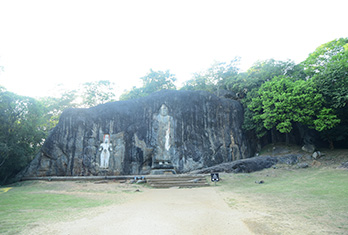
Buduruwagala is one of the unique archaeological site at Monaragala district of Uva province. It has a colossal Buddha image and six more images of Bodhisattavas and their consorts. Some of this images still remains ancient plaster and pigments.
Resvehera or Sesseruwa
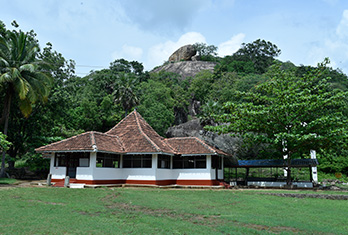
Resvehera or Sasseruva is located in the Kurunegala District of North-Western Province. This religiously significant temple has historical background and there are archaeological evidences belonging to Anuradhapura Period up to Kandy Period.
There are caves with drip ledges and cave inscriptions. These caves are considered as residential complexes of Buddhist monks. There is a cave with Image House belonging to the period of Kandy with Seated Buddha Statues and Standing Buddha statues, Recumbent Buddha Statues, standing statue of a God, and paintings which represent features of period of Kandy.
Asigiri Maha Viharaya
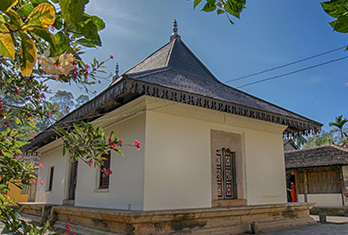
Asgiri Maha Viharaya is the other monastery that holds the custodianship of the Scared Tooth Relic. It is the headquarters of the Asgiriya Chapter of Shyamopali (Siyam)Nikaya. Asgiri Maha Viharaya traces its origin from Wanawasi sector (forest dwellers).
Present chief incumbent of the temple is Ven. Warakagoda Sri Gnanarathana Thera. The monastery has been found during the period of King Parakramabahu IV.
Malwathu Maha Viharaya
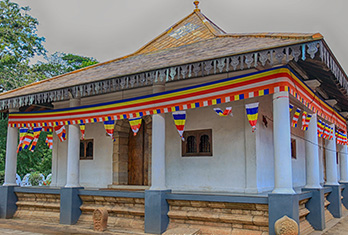
Malwathu Maha Viharaya is a Buddhist monastery located on southern bank of Kandy Lake. It is the headquarters of the Malwatta Chapter of Siyam Nikaya that holds the custodianship of the Scared Tooth Relic.
Malwatu Maha Viharaya traces its origin from Gramawasi sector (village dwellers). This temple is said have been built by King Senasamatha Vikramabahu in the late 15th century. The present chief incumbent of the temple is Ven. Thibbatuwawe Sri Siddhartha Sumangala Thera.
Aththanagalla Rajamaha Viharaya
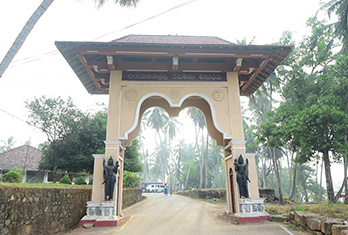
Attanagalla is a famous temple among Buddhist devotes. It is situated in the Gampaha District. According to legends, Attanagalla is considered as the place where King Sirisangabo fulfilled his Dana Paramitha by giving his head to a poor villager.
There is a place within the temple called “hallowed ground” where the king meditated and offered the head. Later King Gotabhaya, brother and successor of Sirisangabo built the temple in Attanagalla.
Pepiliyana Sunethra Devi Pirivena - Colombo
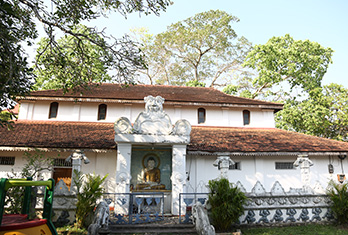
Pepiliyana Sunethra Devi Pirivena is located in Colombo district of Western Province. King Parakramabahu VI of the Kotte Kingdom has built this religious monument in honor of his mother, Queen Sunethradevi.
But there are some other legendry stories related to this. The young prince Parakramabahu used to ride often through the Pepiliyana area with his horse. One rainy day the prince sought shelter in a small hut in the jungle. The hut belonged to a potter, who had a beautiful daughter. The prince has fallen in love with her and began to visit the place often.
Ritigala
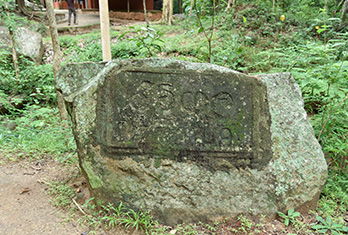
Ritigala is a massive monastic site associated with the mountain range of that name in Anuradhapura District.
There is one of the best monastic site of Padhanagara type at Ritigala. It contains stone paved pathways, staircases, bridges, promenades and similar structured in forest-clad environment. There is a huge pond known as a Banda Pokuna and a Janthagara (Hot water bath) for the benefit of meditative monks.
Rajagala
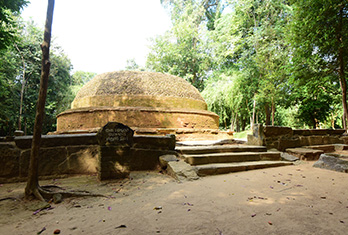
This is a massive Buddhist monastic site at Rajagalatenna , Uhana in the Ampara District of the Eastern Province. It is a forest-clad hill with ruins of various types and different periods since early historic period. This is the place where ashes of Arahat Mahinda and his disciple Ittiya ware enshrined.
Ruins of ancient Dhana Tisa Pavata Vihara , Aritara Vihara and Girikumbhila Vihara were scattered in this monastic complex. There are over ten rock shelters with early Brahmi inscriptions. Some of the caves are having rock art and some primitive sculptures.
Kottimulwala Rajamaha Viharaya

This temple is situated in the Kottimbulwala village in Waligepola division of Ratnapura District. This is a cave temple in a quite forest setting with a long antiquity.
The largest cave is 120 ft in length and 25 ft in width. There are Kandyan style paintings and sculptures in this cave. Some of the caves contain Early Brahmi inscriptions.
Isurumuni Vihare, Anuradhapura
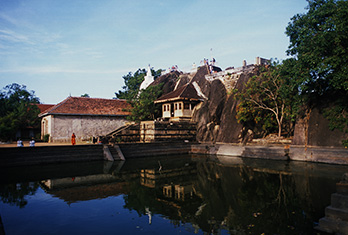
Isurumuniya temple is located south to the Sri Maha Bodhi and at the bank of Tissa Wewa at Anuradhapura. The ancient name of the temple was Meghagiri Vihara where rituals practiced for genaratining rain in the past. According to history, this was the place where the Tooth Relic was first deposited when it was brought to Sri Lanka by prince Danta and princess Hemamala during the reign of king Kithsiri Mewan in the 4th Century CE.
The temple is associated with boulder range which continues from the adjoining royal park, the Ranmasu Uyana. The temple is well known today for its elegant sculptures.

